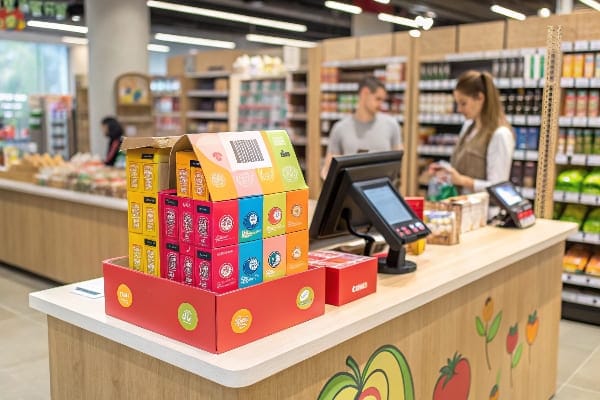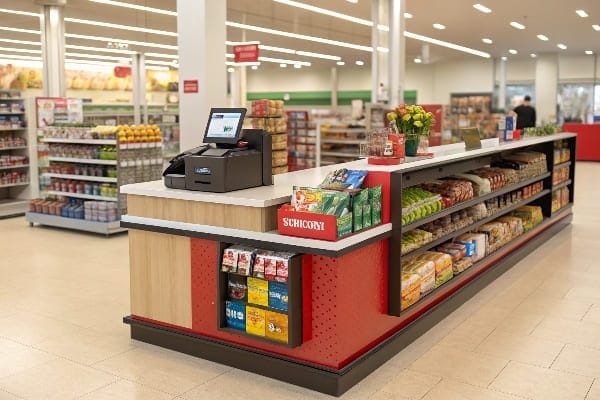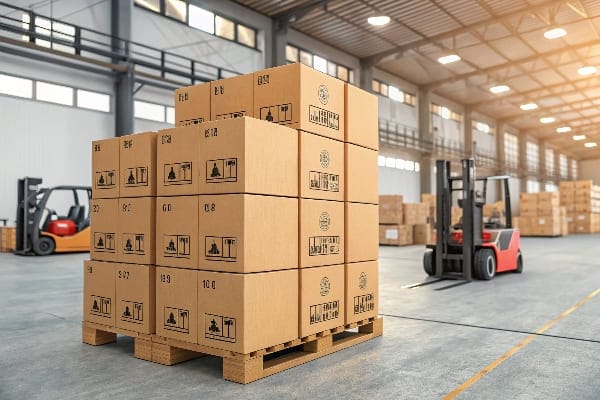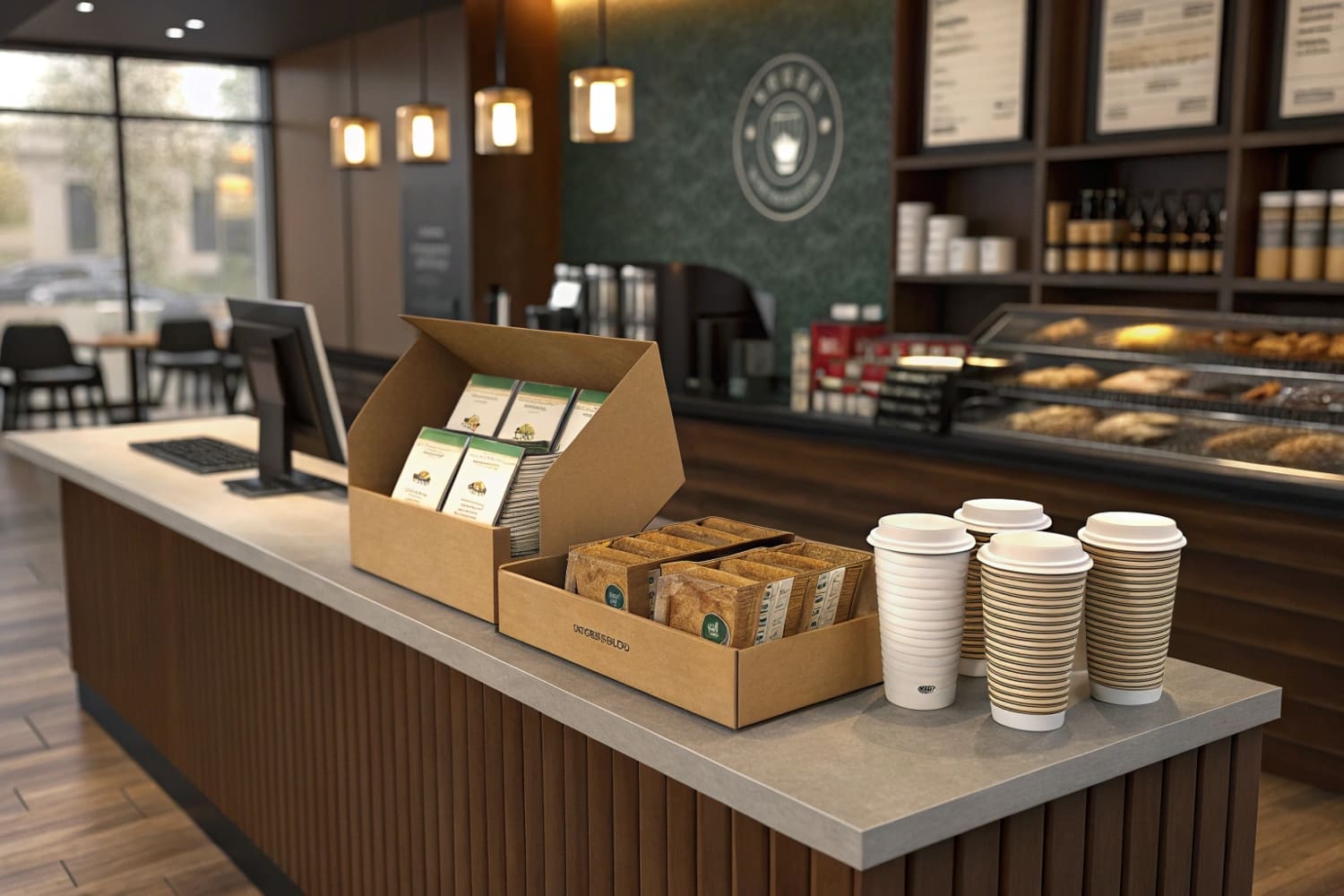I know the panic that creeps in when a product launch is near and the shelf looks bland. It threatens sales and reputation, so urgency spikes.
Cardboard countertop display boxes grab attention fast, boost impulse purchases, and deliver brand stories at eye level while keeping production costs and logistics simple.

Shoppers decide in seconds. I want them staring at my client’s crossbow bolts, not the competitor’s. That is why I keep digging deeper below.
What are cardboard display boxes?
Shoppers scroll past endless choices. Without a clear focal point, my product vanishes inside the noise.
A cardboard display box is a pre-printed, self-standing carton that holds, protects, and promotes retail items on shelves or counters.

How a Simple Box Turns Into a Silent Salesperson
Every box starts as a flat sheet. I work with my design team to plot creases, slots, and locks so the sheet folds into a rigid cradle.
| Step | Task | Why it matters |
|---|---|---|
| Die-cutting | Shapes the outline | Guarantees clean edges |
| Scoring | Adds fold lines | Speeds assembly in store |
| Printing | Adds graphics and UPC | Ensures quick brand recall |
| Gluing/Taping | Locks structure | Keeps load stable |
The material is usually E-flute or B-flute corrugated1. E-flute is thin, so it suits lighter goods like energy bars. B-flute is thicker, so I choose it for heavier hunting tools. Coated liner lets colors pop under LED lights. Uncoated liner gives a rustic feel for eco-friendly brands. I test every prototype with five-kilogram sandbags for 24 hours. If walls bow, I tweak flute direction. That prevents sagging during long promotions.
When talking with buyers like David from Barnett Outdoors, I highlight recycling rates above 80 %2. Big-box retailers now score vendors on sustainability3, so a good box keeps us in their planograms. The right display box is not mere packaging. It is a negotiator, a billboard, and a guard for the goods inside.
What are countertop displays?
Counters crowd fast. Customers tap phones and lean on glass. A weak fixture collapses under that traffic.
A countertop display is any small fixture placed on checkout or service counters that showcases impulse or add-on items within arm’s reach of shoppers.

Placement Science and Buying Psychology
My factory produces floor stands too, yet countertop units4 often convert highest. The human eye naturally drops to waist height, then rises toward the cashier. Placing a display inside that path lifts visibility by up to 40 % in my A/B tests5.
| Location | Average Uplift | Notes from field |
|---|---|---|
| Beside card reader | 45 % | Shoppers wait for payment authorization |
| Next to candy racks | 32 % | High traffic but cluttered |
| On service desk | 27 % | Works for specialty stores |
A tight footprint6 matters. I restrict width to 8 – 12 inches so clerks do not push it aside. Non-slip pads on the base stop sliding when countertops vibrate. Bright brand colors draw the gaze, but I avoid neon for hunting goods; earthy tones fit that demographic. When my client sells broadhead blades, I add a PET window so steel edges remain visible yet safe.
Store staff must set up in under a minute. That is why I ship displays pre-glued, packed flat, with a one-fold pop-up design. They rise like an accordion. No tools, no training videos. Retailers love that and reorder.
What are custom display boxes?
Generic stock dies rarely fit ambitious campaigns. When Barnett Outdoors wants a crossbow shaped top panel, off-the-shelf options fail.
Custom display boxes are tailor-made units designed around specific product size, weight, graphics, and brand goals instead of standard templates.

From Sketch to Mass Run—My Seven-Day Sprint
Custom work looks risky, yet my margins thrive on repeat orders. I keep one rule: prototype in 48 hours7.
| Phase | Duration | Key Deliverable |
|---|---|---|
| Brief | 1 day | Product specs, launch date |
| 3D Render | 1 day | Photoreal draft for approval |
| White Sample | 1 day | Plain cardboard strength test |
| Printed Sample | 2 days | Graphics, structural tweaks |
| Transport Simulation | 1 day | Drop and vibration |
| Production | Variable | 10 K units/day per line |
The blank sample proves geometry. I pour coffee on it, toss it in my van, and drive over potholes. If corners tear, flute orientation changes. My Guangzhou plant holds three auto-glue lines. That lets me absorb rush orders without overtime fees. I accept losses on early design time. Once the die is set, repeat runs flow with minor art swaps, and profit returns.
Customization also secures brand IP. Unique dies deter copycats. For Barnett, I emboss their deer logo into the header. No printer downtown can mimic that depth without the die file. Protection equals leverage in niche markets.
Why are cardboard boxes so expensive?
New buyers gasp at quotes. They think cardboard is cheap, yet my BOM says otherwise.
Cardboard boxes cost more today because raw pulp, energy, labor, and freight prices have surged while retailers demand higher print quality and faster lead times.

Breaking Down the Cost Stack
Last quarter, kraft linerboard8 hit 930 USD per ton, up 18 % year over year. Freight added another 12 % after bunker surcharges. I lay out costs openly for clients.
| Component | % of unit cost | How I control it |
|---|---|---|
| Board material | 47 % | Bulk contracts, local mills |
| Printing plates & inks | 18 % | Reusable plates, water-based ink |
| Labor | 12 % | Automation on glue line |
| Freight | 11 % | Flat-packed pallets, optimized fill |
| Overhead & scrap | 12 % | Lean audits, digital QA |
Energy is volatile. My factory switched to rooftop solar9 for daylight runs. That shaves five cents per unit. Still, electricity at night is unavoidable, so I stack orders to daylight hours for big clients.
Quality demands also rise. Retailers like Walmart require high-gloss litho-laminate10 fronts. That needs extra coating and laminating steps. I explain that upfront; cheaper single-pass flexo will not pass their gate. Education softens sticker shock and shows value rather than cost alone.
What are display boxes called?
Industry jargon confuses newcomers. One buyer’s “PDQ” is another’s “shipper.”
Display boxes also go by PDQ trays, retail ready packaging, shipper displays, dump bins, or POP cartons depending on size and purpose.

Decoding Acronyms to Avoid Costly Misorders
A wrong term can trigger wrong tooling. I keep a glossary in every quote.
| Term | Typical Size | Primary Use |
|---|---|---|
| PDQ (Pretty Darn Quick)11 | ≤ 12″ W | Counter impulse |
| RRP (Retail Ready Packaging12) | 12–24″ W | Shelf display |
| Shipper Display | 24–36″ H | Floor stand, ships product |
| Dump Bin | 24–36″ D | Bulk loose items |
| POP Carton | Any | Generic for point-of-purchase |
Why Words Matter to the Bottom Line
PDQ implies pre-packed inner boxes. If a buyer accidentally says PDQ but wants empty trays, I waste material setting up dividers. Clarity saves mold costs. I train my sales reps to mirror the customer’s term, then confirm dimensions in millimeters. For cross-border orders13, I print both imperial and metric on drawings to stop confusion at the mill.
With Barnett, we agreed to call their unit “counter shipper.” It travels filled with bolts, then the top tears off to act as the display. One SKU, two functions, half the tooling, double the turnover. Vocabulary, when fixed early, drives engineering efficiency and holds the budget.
Conclusion
Cardboard countertop display boxes, when carefully designed and named, shift products from passive stock to active profit engines while keeping costs and clutter low.
Learn about the advantages of different flute types to choose the best packaging for your products. ↩
Understanding the impact of high recycling rates can enhance your packaging strategy and sustainability efforts. ↩
Explore how sustainability trends are shaping packaging design and consumer preferences today. ↩
Explore how countertop units can enhance visibility and conversion rates in retail settings. ↩
Learn how A/B testing can optimize your retail strategies for better customer engagement and sales. ↩
Discover the significance of compact designs in retail displays for maximizing space and customer interaction. ↩
Exploring this resource will provide insights into the advantages of rapid prototyping, enhancing your product development process. ↩
Understanding the current market price of kraft linerboard can help you make informed purchasing decisions and budget effectively. ↩
Exploring the benefits of rooftop solar can reveal how it reduces energy costs and enhances sustainability in manufacturing. ↩
Learning about high-gloss litho-laminate can help you understand its advantages in attracting customers and meeting retailer standards. ↩
Understanding PDQ can help you avoid costly mistakes in packaging and improve efficiency in your orders. ↩
Exploring Retail Ready Packaging can enhance your product display strategies and boost sales effectiveness. ↩
Learn about managing cross-border orders to streamline your international shipping and reduce errors. ↩

